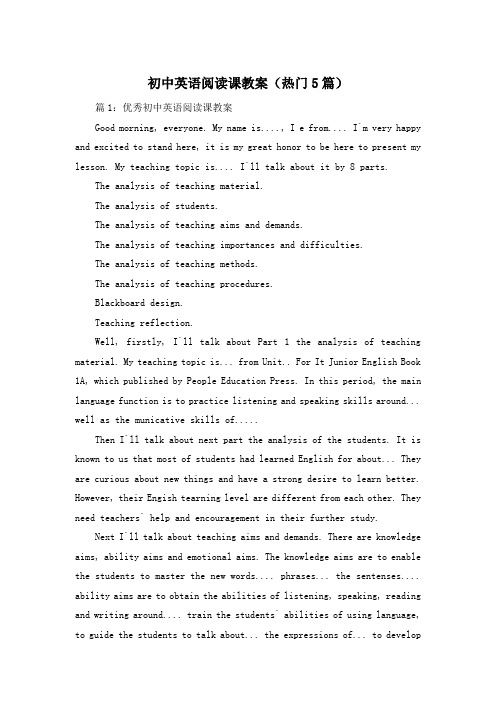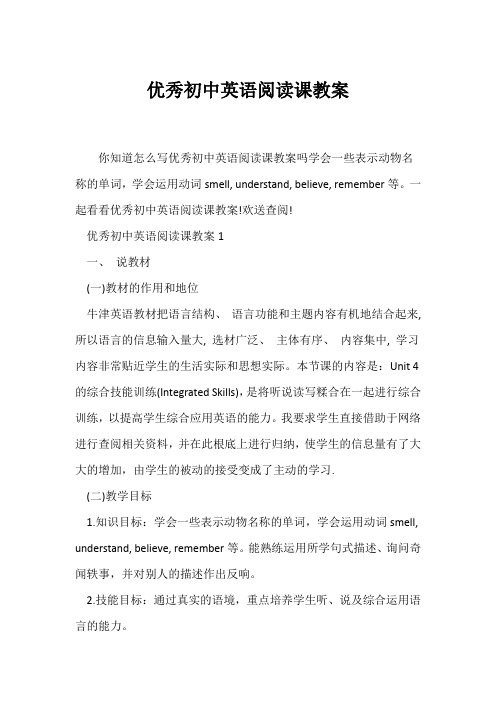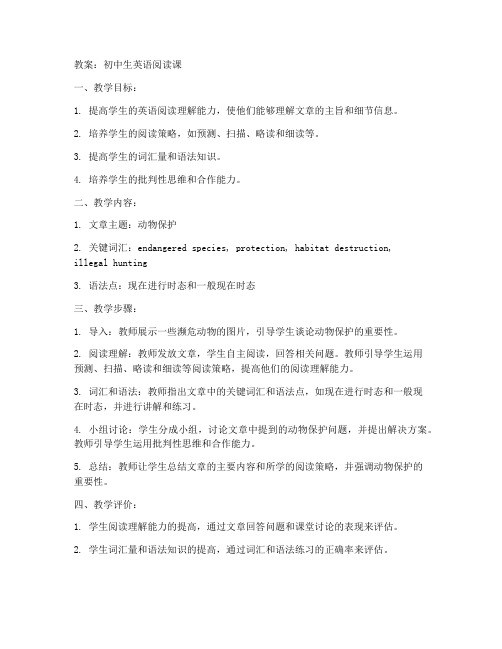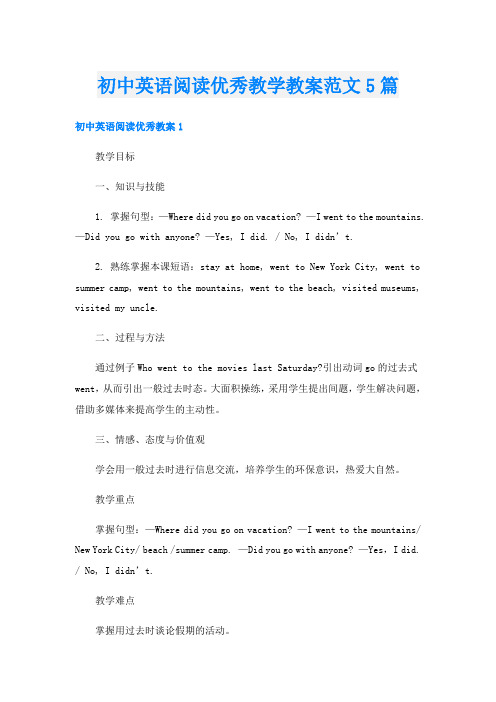最新初中英语阅读课教案
初中英语阅读课教案(热门5篇)

初中英语阅读课教案(热门5篇)篇1:优秀初中英语阅读课教案Good morning, everyone. My name is...., I e from.... I`m very happy and excited to stand here, it is my great honor to be here to present my lesson. My teaching topic is.... I`ll talk about it by 8 parts.The analysis of teaching material.The analysis of students.The analysis of teaching aims and demands.The analysis of teaching importances and difficulties.The analysis of teaching methods.The analysis of teaching procedures.Blackboard design.Teaching reflection.Well, firstly, I`ll talk about Part 1 the analysis of teaching material. My teaching topic is... from Unit.. For It Junior English Book 1A, which published by People Education Press. In this period, the main language function is to practice listening and speaking skills around... well as the municative skills of.....Then I`ll talk about next part the analysis of the students. It is known to us that most of students had learned English for about... They are curious about new things and have a strong desire to learn better. However, their Engish tearning level are different from each other. They need teachers` help and encouragement in their further study.Next I`ll talk about teaching aims and demands. There are knowledge aims, ability aims and emotional aims. The knowledge aims are to enable the students to master the new words.... phrases... the sentenses.... ability aims are to obtain the abilities of listening, speaking, reading and writing around.... train the students` abilities of using language, to guide the students to talk about... the expressions of... to developthe students` ability of creative thinking and cooperative study. The emotional aims are to enable.....Let`s move on to another part: the analysis of teaching importances and difficulties. The teaching importances are... teaching difficulties are.....Next is teaching methods. I use.. in my lesson. There are multimedia puter assisted instruction, task-based activities, situational approach, total physical response or the audio-lingual method.Now I`ll talk about teaching procedures. According to five steps teaching method, I design my lesson into five steps.Step 1 is warm-up. Here I`ll... this, the students can be interested in it and pay their attention to our class easily and....Step 2 is lead-in. Here I`ll... this, the students.....Step 3 is presentation. Here I`ll.... this, the students...... Step 4 is practice. Here I`ll... this, the students......Step 5 is homework. Here I`ll..... this ,the students.....Next is my blackboard design. I`ll design it like this.....At last, I want to say, to be a good teacher is my dream. I think a teacher is not only a guide for sudents, but also a friend of them. If I were a teacher, I would build a close relation with my students, helping them not only on their study but also on their lives. I`ll try my best, and I have confident that I can do it.Ok, that`s all. Thanks for your listening. Good-bye.篇2:优秀初中英语阅读课教案Unit 10 Where did you go on vacation?Good morning, everyone. I am from the . I have taught English for over ten years and I like my students. Today, I will talk about Unit 10 where did you go on vacation? Go for it Junior English Book are 6 periodsto finish this unit. I will talk about the first period with the following parts..I. Analysis of the Teaching Materials.The topic of this unit is the continuation of unit 9 as well as about the past events.By using the Simple PasT Tense,which is essential in junior English,students willtalk about their topic is about their experiences and places they havevisited on their it helps bring back their memories and learning motivations.II. Students’ characteristicAlthough the Junior 1 has been learning English for almost a year and are havingsome basic knowledge. Because of living in China and surrounding environment, students are learning English impassively and irregularly. But The junior 1 has showned themselves very creative,capable and of plasticity as they’re doing so well in what they’re interested in such as games and CAI.Aims and Demandsobjectivesa. To enable the students to read, to spell , to understand the vocabulary correctly.b. To help the students ask and answer the new sentence pattern: Where did you go on vacation?objectives.a. To improve the students’ skills of listening ,speaking,reading and writing..b. To encourage the students to municate with others uning the newsentence pattern .objectivesa. To train the Ss to cooperate well in groups and in pairs.b. To be interested in municating in English.IV. Teaching Key Points1. Key vocabularyNew York City camp summer camp museum2. Key structuresWhere did you go on vacation?I went to…V. Teaching DifficultyLearn the key structuresVI. Teaching Methods1. Task-based methodThat’s to say I’ll let the students finish 1 listening task and make short dialogues along with the actions to help the students get a better understanding of the keystructures.2. munication methodI’ll set up a dream and ask students to pretent themse lves as reporters. This way, the students can say freely and needn’t to worry about making mistakes.VII. Learning Methods1. Listening—speaking method2. municative strategyWe all know that the best ways to learn English well are to imitate,to practice,to listen,to speak and to municate more constantly.VIII. Teaching AidsIn this lesson, the CAI, cassette, a tape recorder will be used.X. Teaching ProcedureI’ll mainly talk about this part. It consists of 5 steps.Step 1 Warm – up and review1. Make a free talk between T-S. What did you do yesterday? And what did your best friend do yesterday?2. Write down the past tenses of the verbs that I show in CAI.Purpose: this step is in order to review what the students have learnt in Unit way, I can lead them into the new lesson smoothly. I think It’s usual but pratical.Step 2 Presentation1. Learn the new words and expressionsa. lead—in: ask students some questions: Did you dream last night? What did you dream? Where did I go on vacation in my dream?b. CAI shows many pictures of my dream,which are also the activities in 1a .c. Ask students to read and spell the new phrases.d. Do 1a. Match the activities with the pictures (a—g).e. Play a guessing game: I will show some jigsaws of each picture and have the students to guess. I will praise the student who answers more quickly.Purpose: I put the vocabulary learning into a dream in order to prompt them to find it very interesting to learn English.. By CAI, students can match the vocabulary with the real things directly and master them easily. Step 3 Listening practicea. Tell the students to listen to the tape and number the people (1—5) in the picture.b. Play the recorder for the first time, and then check the answers.c. Play the recorder again, students imitate the conversations and fill in the blanks. Pay attention to their pronunciation and intonation.Purpose: this is a basic and necessary step, which develops the students’ skills of listening, reading and writing.Step 4 Pairworka. T—S: where did Tina go on vacation?She went to the mountains.b. Ask the students to practice in pairs as we 1c. Then they will e to the platform and click on the number to choose a picture and act it out randomlyPurpose: “Task-based”teaching method is used here to develop the students’ability ofmunication and their ability of co-operation will be well trained. This step provides guided oral practice using the target language to consolidate the key structure and It can develop students’ skill of speaking and sense of language.Step5 ProductionHave students pretent to be reporters to interview anyone they want to ask about their vacation.Purpose: After learning 1a—1c, it’s time to extend what they learnt just now and give the students a free space to show their abilities. With the real situations, students will feel easy and successful during this part. By way of munication, the students will understand how to use the key structure better and consolidate the knowledge firmly.Part XI HomeworkDo a survey and write a report about the classmates’ vocation. Purpose: I think homework is so important that the students can speak english as much as they can in class or after set this step in order to practice students’ skills of listening, speaking and writing.Blackboard Design篇3:优秀初中英语阅读课教案教学目标教学目标Aim 记忆物品pants , socks , T-shirt , shirt , shorts , sweater , shoes理解颜色理解:color , black , white , red , green , blue ,应用通过布置任务,让学生在合作中进行语言交流。
(英语教案)优秀初中英语阅读课教案

优秀初中英语阅读课教案你知道怎么写优秀初中英语阅读课教案吗学会一些表示动物名称的单词,学会运用动词smell, understand, believe, remember等。
一起看看优秀初中英语阅读课教案!欢送查阅!优秀初中英语阅读课教案1一、说教材(一)教材的作用和地位牛津英语教材把语言结构、语言功能和主题内容有机地结合起来, 所以语言的信息输入量大, 选材广泛、主体有序、内容集中, 学习内容非常贴近学生的生活实际和思想实际。
本节课的内容是:Unit 4 的综合技能训练(Integrated Skills),是将听说读写糅合在一起进行综合训练,以提高学生综合应用英语的能力。
我要求学生直接借助于网络进行查阅相关资料,并在此根底上进行归纳,使学生的信息量有了大大的增加,由学生的被动的接受变成了主动的学习.(二)教学目标1.知识目标:学会一些表示动物名称的单词,学会运用动词smell, understand, believe, remember等。
能熟练运用所学句式描述、询问奇闻轶事,并对别人的描述作出反响。
2.技能目标:通过真实的语境,重点培养学生听、说及综合运用语言的能力。
3.情感目标:培养学生的参与意识、竞争意识和合作精神,激发学生对我们所处的世界的热爱和不断探索未知世界的兴趣。
二、说教法(一)教学设计的原那么1 坚持自主学习,合作学习的教学原那么教师打破了以教师为中心, 单项灌输的陈旧模式, 在课堂教学中尽可能发挥学生的主动性和合作精神, 营造了良好的学习气氛, 更重要的是在频繁的交流中, 学生的语言表达能力提高了。
2 遵循英语教学的交际性原那么交际性原那么是英语教学中的一个指导性原那么, 教学最终的目的不仅要使学生掌握知识, 更重要的是使学生在理解的根底上, 在交际性练习中培养交际能力,而培养这种交际能力, 就是反映在课堂教学中学生以主人翁态度, 积极、主动、大胆地参与英语课堂练习活动的主体意识上。
阅读教案英语初中模板

阅读教案英语初中模板一、教学目标1. 知识目标了解文章背景,掌握相关词汇和短语。
2. 能力目标提高学生的阅读理解能力,培养学生的推测和判断能力。
3. 情感目标激发学生对英语阅读的兴趣,培养他们的阅读习惯。
二、教学内容1. 教材内容人教版初中英语教材(或其他版本),选定一篇阅读文章。
2. 教学重难点词汇和短语的理解,阅读策略的运用。
三、教学过程1. Pre-reading(读前活动)(1)引入话题:通过与学生生活相关的话题,激发学生的阅读兴趣。
(2)预测内容:让学生根据标题和图片,预测文章内容。
2. While-reading(读中活动)(1)快速阅读:让学生快速阅读文章,了解大意。
(2)细节理解:回答关于文章的事实性问题。
(3)推测判断:根据文章内容,进行推理判断。
(4)词汇学习:学习文章中的新词汇和短语。
3. Post-reading(读后活动)(1)复述文章:让学生用自己的话复述文章内容。
(2)讨论交流:分组讨论,分享阅读心得。
(3)拓展活动:根据文章内容,设计相关拓展活动。
四、教学评价1. 课堂表现:观察学生在课堂上的参与程度,积极主动性。
2. 阅读理解:通过回答问题,检查学生的阅读理解能力。
3. 拓展活动:评估学生在拓展活动中的表现,检验他们的综合运用能力。
五、教学反思课后,教师应认真反思教学效果,针对学生的掌握情况,调整教学策略,以提高教学效果。
以上是一份英语初中阅读教案的模板,具体内容需要根据所选文章和学生的实际情况进行调整。
希望对您的教学有所帮助。
初中生_英语阅读教案

教案:初中生英语阅读课一、教学目标:1. 提高学生的英语阅读理解能力,使他们能够理解文章的主旨和细节信息。
2. 培养学生的阅读策略,如预测、扫描、略读和细读等。
3. 提高学生的词汇量和语法知识。
4. 培养学生的批判性思维和合作能力。
二、教学内容:1. 文章主题:动物保护2. 关键词汇:endangered species, protection, habitat destruction,illegal hunting3. 语法点:现在进行时态和一般现在时态三、教学步骤:1. 导入:教师展示一些濒危动物的图片,引导学生谈论动物保护的重要性。
2. 阅读理解:教师发放文章,学生自主阅读,回答相关问题。
教师引导学生运用预测、扫描、略读和细读等阅读策略,提高他们的阅读理解能力。
3. 词汇和语法:教师指出文章中的关键词汇和语法点,如现在进行时态和一般现在时态,并进行讲解和练习。
4. 小组讨论:学生分成小组,讨论文章中提到的动物保护问题,并提出解决方案。
教师引导学生运用批判性思维和合作能力。
5. 总结:教师让学生总结文章的主要内容和所学的阅读策略,并强调动物保护的重要性。
四、教学评价:1. 学生阅读理解能力的提高,通过文章回答问题和课堂讨论的表现来评估。
2. 学生词汇量和语法知识的提高,通过词汇和语法练习的正确率来评估。
3. 学生批判性思维和合作能力的提高,通过小组讨论的表现和提出的解决方案来评估。
五、教学资源:1. 文章:关于动物保护的英文文章。
2. 图片:濒危动物的图片。
3. 词汇和语法练习:相关的练习题。
六、教学时间:1课时(40分钟)七、教学建议:1. 在课堂上鼓励学生积极参与,提高他们的自信心和兴趣。
2. 针对不同学生的水平,可以适当调整教学内容和难度。
3. 鼓励学生在课后进行自主阅读,扩大词汇量和提高阅读能力。
4. 注重培养学生的批判性思维和合作能力,提高他们的综合素养。
初中英语阅读优秀教学教案范文5篇

初中英语阅读优秀教学教案范文5篇初中英语阅读优秀教案1教学目标一、知识与技能1. 掌握句型:—Where did you go on vacation? —I went to the mountains. —Did you go with anyone? —Yes, I did. / No, I didn’t.2. 熟练掌握本课短语:stay at home, went to New York City, went to summer camp, went to the mountains, went to the beach, visited museums, visited my uncle.二、过程与方法通过例子Who went to the movies last Saturday?引出动词go的过去式went,从而引出一般过去时态。
大面积操练,采用学生提出间题,学生解决问题,借助多媒体来提高学生的主动性。
三、情感、态度与价值观学会用一般过去时进行信息交流,培养学生的环保意识,热爱大自然。
教学重点掌握句型:—Where did you go on vacation? —I went to the mountains/ New York City/ beach /summer camp. —Did you go with anyone? —Yes,I did. / No, I didn’t.教学难点掌握用过去时谈论假期的活动。
教法导航通过看图、看视频、听录音、问答、讨论等方法学习谈论能力和表达愿望。
学法导航通过看、听、说等各种途径,以小组合作的形式,主动探求知识,锻炼自主学习能力。
教学准备图片,多媒体。
教学过程Step 1 GreetingsGreet the class.Step 2 Lead inAsk questions about what students did last Saturday.(1)Who went to the movies last Saturday? Point to one student who raises his or her hand. Sara went to the movies last Saturday. Repeat.Write this sentence on the board.Underline the word went.(2)Ask:Who visited a friend last Saturday?Point to one student who raises his or her hand.Carlos visited a friend last Saturday.Repeat. Write this sentence on the board. Underline the word “visited”.Point to the words went and visited in the sentences on the board.Say:We use these words to talk about things that happened in the past. Writethese pairs of words on the board:go–went, visit –visited. Ask: Can you point out the words that talk about the past?This activity introduces the key vocabulary.Step 3 Practice1. Focus attention on the picture.Ask: What can you see?Say: Each picture shows something a person did in the each activity and ask students to repeat: went to the mountains, went to New York City, went to summer camp, visited my uncle,stayed at home, went to the beach, visited museums.2.Point to the numbered list of activities.Say each one again and ask the students to repeat.3.Now, please match each phrase with one of the pictures.Say:Write the letter of each picture next to the name of the activity.Point to the sample answer.4.Check the answers.Step 4 Listening1.Point to the picture on the screen. Say: look at Picture A,Where did Tina go on vacation? Yes,she went to the mountains.Ask:What did the person do in each scene? Say: There are three conversations. Play the recording the first time.2. The people talk about what they did on vacation.Listen to the recording and write numbers of the names in the right boxes in the picture.Please write only 5 numbers. Point out the sample answer next to the picture showing went to the mountain. Play the recording a second time.3.Correct the answers.Step 5 Pair workPoint out the example conversation. Ask two students to read the dialogue to the class. Say the dialogue in the picture with a student,Do a second example to the class. Then say:Now work with a partner, make conversations about the people in the pictures.As they talk,move around the classroom monitoring their work. Offer language or pronunciation support as needed.Step 6 Listening1.2a. Ask: Where did the people go on vacation? And then ask the students to listen carefully and fill in the chart. Play the recording twice and then check the answers.2. Look at the form carefully, ask: Did the people do the following things? Then ask thestudents to listen carefully and check the anwers. Play twice and ask the students to check the answers in pairs and then check the answers together.Step 7 Role playLook at the form again carefully and make role-play conversations among Grace, Kevin and Julie. Ask one or two groups to show the conversation first and then get the students to practice in groups.初中英语阅读优秀教案2教学目标学习打招呼的用语,询问姓名和相互间的问候。
初中英语拓展课外阅读教案

初中英语拓展课外阅读教案教学目标:1. 提高学生的阅读理解能力,培养学生的阅读兴趣。
2. 扩大学生的词汇量,提高学生的英语水平。
3. 培养学生自主学习的能力,提高学生的学习积极性。
教学内容:1. 选择一篇适合初中生阅读的英语文章,文章内容要有趣味性,能够吸引学生的注意力。
2. 文章难度要适中,不能过于简单或过于困难。
3. 文章主题要积极向上,能够对学生有所启发和帮助。
教学步骤:Step 1: 引入话题1. 教师可以先向学生介绍文章的标题和作者,引起学生的兴趣。
2. 教师可以提问学生一些与文章相关的问题,引导学生思考。
Step 2: 阅读文章1. 学生自主阅读文章,理解文章内容。
2. 学生可以边读边做笔记,记录下关键词汇和重要信息。
Step 3: 讨论和分享1. 教师可以组织学生进行小组讨论,让学生分享自己的阅读心得和感悟。
2. 教师可以引导学生讨论文章中的难点和疑点,帮助学生更好地理解文章。
Step 4: 扩展活动1. 教师可以引导学生进行扩展活动,如写作、演讲、角色扮演等,让学生运用所学知识进行实际操作。
2. 教师可以给学生提供一些与文章相关的阅读材料,让学生进行拓展阅读。
Step 5: 总结和反思1. 教师可以引导学生总结文章的主要内容和观点,帮助学生巩固所学知识。
2. 教师可以反思本次阅读活动的效果,找出不足之处,为下一次活动做好准备。
教学评价:1. 观察学生在阅读过程中的表现,如阅读速度、阅读理解能力等。
2. 听取学生的反馈意见,了解学生的学习需求和兴趣。
3. 通过学生的扩展活动成果,评估学生的学习效果。
注意事项:1. 教师要关注学生的个体差异,给予不同水平的学生不同的指导和帮助。
2. 教师要鼓励学生积极参与阅读活动,培养学生的阅读习惯。
3. 教师要注重阅读材料的筛选,确保文章的质量。
初中英语阅读课教案

初中英语阅读课教案教案一:阅读理解 - 电影观影技巧教学目标:1. 学生能够运用阅读技巧和策略,提高阅读理解能力。
2. 学生能够理解并运用关键词、上下文和推理来帮助解读文章。
3. 学生能够阅读和理解有关电影观影技巧的文章,并从中获取有用信息。
教学步骤:Step 1:导入新课1. 和学生一起回顾上节课所学的阅读技巧和策略,如关键词、上下文和推理。
2. 引入新课的主题:电影观影技巧。
向学生解释这个主题的重要性,了解观影技巧对于提升观影体验的作用。
Step 2:阅读理解训练1. 教师向学生展示一篇关于电影观影技巧的文章,并提供适当的语言支持。
2. 学生在阅读文章时应注意关键词,并尝试从上下文中推断出单词的意思。
3. 学生可以将文章中不熟悉的单词和短语记录下来,以便后续的词汇扩展练习。
Step 3:小组合作1. 将学生分为小组,让他们讨论文章中的问题和练习。
2. 鼓励学生相互合作和交流,分享彼此的解答,以加深理解。
Step 4:全班讨论和分享1. 邀请学生分享他们的答案和解决方法。
2. 引导学生通过对比归纳总结的方式找出最佳的解题策略。
Step 5:拓展活动1. 教师可以引导学生参观电影院,了解电影放映的背后工作。
2. 学生可以编写一份电影评论,分享他们对于观影技巧的理解和应用。
教学反思与评估:通过本节课的教学,学生们能够提高自己的阅读理解能力,并应用关键词、上下文和推理来解读文章。
通过小组合作和全班讨论,学生们能够相互交流并分享彼此的解答策略。
拓展活动能够进一步激发学生的兴趣,并提高他们的观影技巧。
通过教师的评估,可以了解学生的学习成果和掌握情况。
【校本教材】校本课程初中英语阅读、写作 教案

【校本教材】初中英语阅读与写作教案一、教学目标:2. 提升学生的英语阅读理解能力,丰富他们的英语文化知识。
3. 加强学生的英语写作技巧,提高写作水平。
4. 增强学生的英语语感,提高综合运用英语的能力。
二、教学内容:1. 选择适合初中生阅读水平的英语文章,涉及不同题材,如故事、科普、文化等。
2. 通过阅读,学习并掌握常用的英语阅读策略,如预测、扫读、细读、推论等。
3. 学习英语文章的基本结构,提高学生的写作布局能力。
4. 通过仿写、改写等实践活动,提高学生的英语写作能力。
三、教学方法:1. 任务型教学法:通过设定各种阅读任务,引导学生主动探究,提高阅读理解能力。
2. 互动式教学法:鼓励学生积极参与课堂讨论,分享阅读心得,提高口头表达能力。
3. 启发式教学法:教师引导学生思考,激发学生的学习兴趣,培养创新意识。
4. 同伴教学法:学生相互评价、反馈,共同提高。
四、教学评估:1. 过程性评估:关注学生在课堂上的参与度、合作能力和进步情况。
2. 终结性评估:定期进行阅读理解和写作测试,检验学生的学习成果。
3. 自我评估:鼓励学生反思自己的学习过程,找出不足,制定改进措施。
五、教学计划:1. 第1-2周:导入阶段,介绍课程目标、内容和要求,激发学生的学习兴趣。
2. 第3-4周:阅读策略学习,引导学生掌握基本的阅读技巧。
3. 第5-8周:阅读实践,让学生运用所学阅读策略,阅读不同题材的文章。
4. 第9-10周:写作技巧学习,教授英语文章的基本结构和写作方法。
5. 第11-12周:写作实践,学生进行仿写、改写等实践活动,提高写作水平。
六、教学资源:1. 英语阅读材料:选择适合初中生阅读水平的英语文章,涉及不同题材,如故事、科普、文化等。
2. 教学多媒体资源:课件、视频、音频等。
3. 写作模板和示例:提供各种写作模板和优秀示例,帮助学生掌握写作结构和方法。
4. 评价工具:阅读理解测试题、写作评分标准等。
七、教学步骤:1. 导入:通过提问、讨论等方式,引导学生进入学习主题。
- 1、下载文档前请自行甄别文档内容的完整性,平台不提供额外的编辑、内容补充、找答案等附加服务。
- 2、"仅部分预览"的文档,不可在线预览部分如存在完整性等问题,可反馈申请退款(可完整预览的文档不适用该条件!)。
- 3、如文档侵犯您的权益,请联系客服反馈,我们会尽快为您处理(人工客服工作时间:9:00-18:30)。
LESSON PLANTime of Lesson: 45 minutesStudents: Senior Grade OneTeaching Material: How Did Postage Stamps Come Into Use Teaching Objectives:1. To train Ss\' reading ability(such as guessing the meaning of new words in the context, the speed of reading.)2. To train Ss\' reading comprehension(To get messages from what they read.)Teaching Points:1. Ss get used to three reading skills.2. Ss understand the given passage.Properties:Stamps, letters, postcards, work sheets, OHPTeaching Method:Communicative ApproachLesson Type:ReadingNew Words and A Phrase:postage, put forward, proposal, seal, deliver, system, postalProcedures:Step 1. Warm-up(6\')1. Lead-inShow some stamps, letters and postcards and have free talk to arouse students\' motivation.2. Dealing with some new wordsQ: Do you know the postage of a letter?Explain \"postage\", and write postage on the Bb.postage: payment for the carrying of lettersA: Fifty fen for any place in China except Hong Kong, Taiwan and Macao.Q: What do the postmen do with the letters?A: They take the letters from the postbox and carry them away to the places on the envelopes and deliver them to the addressed people.Explain \"deliver\", and write deliver on the Bb.deliver: take letters or goods to the addressed people.Q: Who put forward the proposal to use stamps? Use OHP to project the question onto the screen.Explain \"put forward\" and \"proposal\", and write them on the Bb.put forward: put an idea before people for thinking over proposal: sth. proposed, plan or idea, suggestionAgain: Who put forward the proposal to use stamps?Step 2. Skimming(4\'30\")1. InstructionsT: Now I give you a passage to read, and for the first time you should only find the answer to the question. You have only twoand a half minutes to read. So don\'t read word for word. Read quickly. Just try to find the answer.2. Handing out the reading material and reading3. CheckingQ: Who put forward the proposal to use stamps.A: Rowland Hill, a schoolmaster in England.Step 3. Scanning(6\')1. InstructionsT: This time I give you three minutes to read the passage. When you are reading, find the answers to the two questions.Use OHP to project the questions:1. Why was the postage high in the early nineteenth century when people did not use stamps?2. When was postage stamps first put to use?2. Reading3. Checking1) Pair work2) Class checkingAns. to Que.1. Because the post offices had to send many people to collect the postage.Ans. to Que.2. On May 6, 1840.Step 4. Full reading(21\')1. InstructionsT: Now I give you ten minutes to read the passage for the third time and you should read it carefully. Before reading, let\'s go over the questions on the work sheet.Give Work Sheet 1 to the Ss. Explain the new words in Que. 4. prevent: stop, not let sb. do sth.reuse: use againT: Try to find the answers to the questions. But don\'t write the answers down, you can put a sign or underline the sentences concerning the questions.2. Reading3. Checking1) Group work: Checking the answers in a group of four Ss.2) Class work: Checking the answers in class.Possible Answers:1. Why were people unhappy to pay postage for letters in the early nineteenth century?Because they had to pay postage when they received letters, especially when they paid for a letter which they did not wish to receive at all. The postage was high.2. Why was it much easier for people to use stamps for postage? Because people could go to the nearby post office to buy stamps and put them on envelopes before they sent the letters.3. Why was the postage much lower using stamps?Because in this way, the post office did not need to send postmen to collect postage. It only needed to send fewer postmen to deliver letters.4. How could the post office prevent people from reusing the stamps?The post office could simply put seals on the stamps so that people could not use the stamps again.Check the understanding of the word \"seal\", and write it on the Bb.seal: ÓÊ´Á 5. Did other countries take up the new postal system?Yes.Check the understanding of \"postal\" and \"system\", and write them on the Bb.postal: of the postsystem: a set of working ways6. Does every country in the world has its own stamps? Yes.Step 5: Rounding-off(7\')1. Answering Ss\' questions on the passage if any.2. Making a guided-dialogue with the information given from the passage.Hand out Work Sheet 2. Do it in pairs.3. Asking two or three pairs to read their dailogues.A possible completed dialogue:A: Oh, What a beautiful stamp!B: Yes, it\'s from the U.S.A..A: Do you know in the early nineteenth century people did not use stamps?B: Then how did they pay the postage?A: They had to pay the postage when they received letters. B: Was the postage very high then?A: Yes. Because the post offices had to send many people to collect the postage.B: Who put forward the proposal to use stamps?A: Rowland Hill, a schoolmaster in England.B: Why do post offices put seals on the stamps?A: They can prevent people from using the stamps again.B: When did post offices begin to sell stamps?A: On May 6, 1840.B: Thank you for telling me so many things about stamps. Step 6. Assignment(30\")Ask the Ss to shorten the passage within four or five sentences after class, and to write it in their exercise books.*********************************************************** **Reading Material:How Did Postage Stamps Come Into UseWhen you send a letter or a postcard, you have to put stamps on the envelope or on the card. When did people first begin to use stamps? Who was the first to think of this idea?In the early nineteenth century, people did not use stamps. They had to pay postage when they received letters. They were unhappy about this, especially when they paid for a letter which they did not wish to receive at all. The postage was high at thattime, because the post offices had to send many people to collect the postage.Rowland Hill, a schoolmaster in England, was the first to put forward a proposal to use stamps. He thought it would be much easier for people to use stamps to cover postage. They could go to the nearby post office to buy stamps and put them on envelopes before they sent the letters. The post office could simply put seals on the stamps so that people could not use the stamps again. In this way, the post office did not need to send postmen to collect postage. It only needed to send fewer postmen to deliver letters. That was a good idea and the government finally accepted it.On May 6, 1840, post offices throughout England began to sell stamps. Soon this new postal system was taken up by other countries. Now each country has its own stamps. And there are many people who collect stamps all over the world.Work Sheet 1:Find the answers to the following questions from the passage: 1. Why were people unhappy to pay postage for letters in the early nineteenth century?2. Why was it much easier for people to use stamps for postage?3. Why was the postage much lower using stamps?4. How could the post office prevent people from reusing the stamps?5. Did other countries take up the new postal system?6. Does every country in the world has its own stamps now? Work Sheet 2:Complete the dialogue with the information you have got: A: Oh, What a beautiful stamp!B: Yes, it\'s from the U.S.A..A: Do you know ____________________ people did not use stamps?B: Then how did they pay the postage?A:___________________________________________________________ .B: Was the postage very high then?A:___________________________________________________________ .B: Who put forward the proposal to use stamps?A:___________________________________________________________ .B: Why do post offices put seals on the stamps?A:___________________________________________________________ .B: When did post offices begin to sell stamps?A:___________________________________________________________ .B: Thank you for telling me so many things about stamps.。
